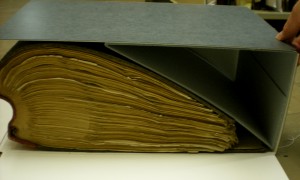We are finding many challenges in preparing our materials for the upcoming move. Erin Hammeke, Special Collections Conservator, shares the following find from her work as the project coordinator for the ledger project.

As part of the enabling project we are working in our ledger collection to prepare these materials for the move. The Mooresville Mill manufactured cotton, wool, and synthetic fabrics in Mooresville, North Carolina, from the late 19th century to the mid-20th. When the company’s stocks were sold back, they were cancelled and glued onto the stubs bound into a ledger book. The stock certificates were also glued in, leaving the book with a fore edge 2-3 times the thickness of the spine. We started calling these ‘swirl books’ because of their exceptional shape. These items really seem more akin to sculpture than book bindings.
We consulted with the head of collection development in the Rubenstein Library and we agreed that treatment would be too time-consuming of an option before the move. We decided to house the swirl books as they were. Needless to say, these items posed unique shelving and housing challenges to us.
Our technician, Tedd Anderson, bravely met the challenge. For each ledger, Tedd created a wedge to accommodate the shape of the original so that they would fit inside a custom phase box. They can now be shelved safely and are protected from further damage. These will go in our conservation treatment request database for future treatment.



